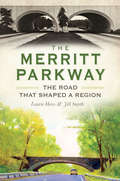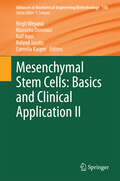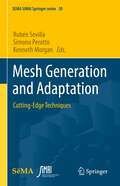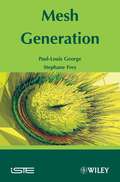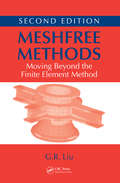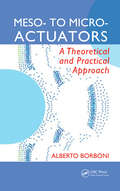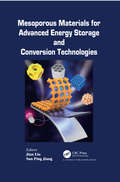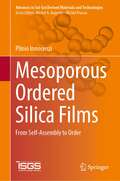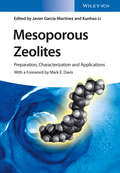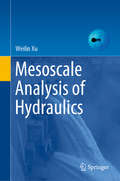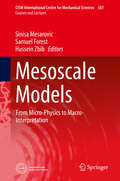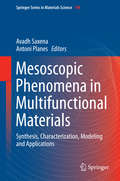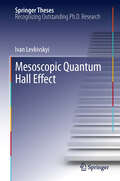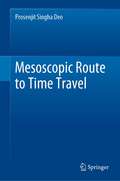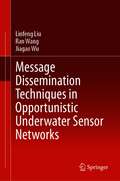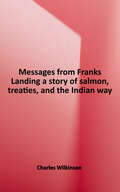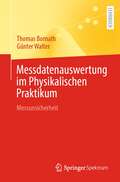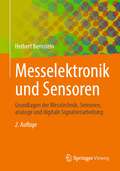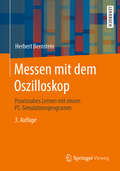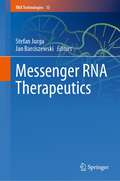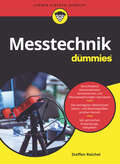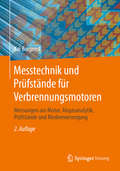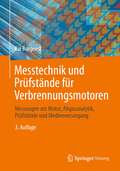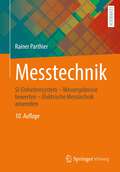- Table View
- List View
Merritt Parkway, The: The Road that Shaped a Region (Transportation)
by Laurie Heiss Jill SmythDecorated with a breathtaking landscape and a treasured collection of diversely styled bridges, the Merritt Parkway runs thirty-seven and a half miles through Fairfield County. From its complicated beginnings to the present, authors Laurie Heiss and Jill Smyth navigate the hard-fought yet picturesque path of this beloved road. Meet the bridge artist, the landscapers, the politicians and the activists whose involvement in the Merritt transformed Fairfield County from farms and country estates to one of the wealthiest counties in the nation. With the dedication of preservationists and conservationists, the Merritt Parkway today remains both functional and beautiful, holding a unique place in the heart of Connecticut's drivers.
Mesenchymal Stem Cells - Basics and Clinical Application I
by Birgit Weyand Ralf Hass Roland Jacobs Massimo Dominici Cornelia KasperProspective Isolation and Characterization of Human Bone Marrow-Derived MSCs, by A. Harichandan, K. Sivasubramaniyan, H.-J. Bühring Urine as a Source of Stem Cells, by Christina Benda, Ting Zhou, Xianming Wang, Weihua Tian, Johannes Grillari, Hung-Fat Tse, Regina Grillari-Voglauer, Duanqing Pei, Miguel A. Esteban Expansion of Mesenchymal Stem/Stromal Cells under Xenogenic-Free Culture Conditions, by Sven Kinzebach, Karen Bieback Adipose-Derived Mesenchymal Stem Cells: Biology and Potential Applications, by Danielle Minteer, Kacey G Marra, J Peter Rubin Potential for Osteogenic and Chondrogenic Differentiation of MSC, by Antonina Lavrentieva, Tim Hatlapatka, Anne Neumann, Birgit Weyand, Cornelia Kasper Potential for Neural Differentiation of Mesenchymal Stem Cells, by Letizia Ferroni, Chiara Gardin, Ilaria Tocco, Roberta Epis, Alessandro Casadei, Vincenzo Vindigni, Giuseppe Mucci, Barbara Zavan Migratory Properties of Mesenchymal Stem Cells, by Thomas Dittmar, Frank Entschladen Dissecting Paracrine Effectors for Mesenchymal Stem Cells, by Stefania Bruno, Federica Collino, Ciro Tetta, Giovanni Camussi Proteomics Approaches in the Identification of Molecular Signatures of Mesenchymal Stem Cells, by Yin Xiao, Jiezhong Chen Does the Adult Stroma Contain Stem Cells?, by Richard Schäfer
Mesh Generation and Adaptation: Cutting-Edge Techniques (SEMA SIMAI Springer Series #30)
by Kenneth Morgan Simona Perotto Rubén SevillaThe developments in mesh generation are usually driven by the needs of new applications and/or novel algorithms. The last decade has seen a renewed interest in mesh generation and adaptation by the computational engineering community, due to the challenges introduced by complex industrial problems.Another common challenge is the need to handle complex geometries. Nowadays, it is becoming obvious that geometry should be persistent throughout the whole simulation process. Several methodologies that can carry the geometric information throughout the simulation stage are available, but due to the novelty of these methods, the generation of suitable meshes for these techniques is still the main obstacle for the industrial uptake of this technology.This book will cover different aspects of mesh generation and adaptation, with particular emphasis on cutting-edge mesh generation techniques for advanced discretisation methods and complex geometries.
Mesh Generation: Application to Finite Elements (Wiley-iste Ser.)
by Pascal Frey Paul Louis GeorgeThe aim of the second edition of this book is to provide a comprehensive survey of the different algorithms and data structures useful for triangulation and meshing construction. In addition, several aspects are given full coverage, such as mesh modification tools, mesh evaluation criteria, mesh optimization, adaptive mesh construction and parallel meshing techniques. This new edition has been comprehensively updated and also includes a new chapter on mobile or deformable meshes.
Meshfree Methods: Moving Beyond the Finite Element Method, Second Edition
by G.R. LiuUnderstand How to Use and Develop Meshfree TechniquesAn Update of a Groundbreaking WorkReflecting the significant advances made in the field since the publication of its predecessor, Meshfree Methods: Moving Beyond the Finite Element Method, Second Edition systematically covers the most widely used meshfree methods. With 70% new material, this edit
Meso- to Micro- Actuators: A Theoretical and Practical Approach
by Alberto BorboniExploring the design and use of micro- and meso-actuators, this book begins with theory and a general synopsis of the state-of-the-art in theoretical research. It discusses how to employ modern approaches in research and design activity, then presents a systematic list of already available products and details their potential for use. Design possib
Mesoporous Materials for Advanced Energy Storage and Conversion Technologies
by San Ping Jiang Jian LiuInnovation through specific and rational design and functionalization has led to the development of a wide range of mesoporous materials with varying morphologies (hexagonal, cubic, rod-like), structures (silicates, carbons, metal oxides), and unique functionalities (doping, acid functionalization) that currently makes this field one of the most exciting in materials science and energy applications. This book focuses primarily on the rapid progress in their application in energy conversion and storage technologies, including supercapacitor, Li-ion battery, fuel cells, solar cells, and photocatalysis (water splitting) and will serve as a valuable reference for researchers in the field
Mesoporous Ordered Silica Films: From Self-Assembly to Order (Advances in Sol-Gel Derived Materials and Technologies)
by Plinio InnocenziThis book introduces the fascinating world of self-assembly in mesoporous ordered silica films. Beginning from a single droplet, it guides the reader, in a step-by-step learning process, how to obtain and control ordered porous mesophases in thin films by varying only the precursor chemistry and the process. It explains, in great detail, how order control is achieved through chemical design and post-deposition processing, the latter of which is a unique property in materials science. The book places a special focus on silica, whose particularly complex chemistry enables order control over a range of different length scales. This book is suitable for students and researchers in the fields of sol-gel or colloidal chemistry and interested in the topics of self-assembly and mesoporous phases.
Mesoporous Zeolites
by Javier García-Martínez Mark E. Davis Kunhao LiAuthored by a top-level team of both academic and industrial researchers in the field, this is an up-to-date review of mesoporous zeolites. The leading experts cover novel preparation methods that allow for a purpose-oriented fine-tuning of zeolite properties, as well as the related materials, discussing the specific characterization methods and the applications in close relation to each individual preparation approach. The result is a self-contained treatment of the different classes of mesoporous zeolites. With its academic insights and practical relevance this is a comprehensive handbook for researchers in the field and related areas, as well as for developers from the chemical industry.
Mesoscale Analysis of Hydraulics
by Weilin XuThis open access book presents a series of complicated hydraulic phenomena and related mechanism of high-speed flows in head-head dam. According to the basic hydraulic theory, detailed experiments and numerical simulations, microscopic scale analysis on cavitation bubbles, air bubbles, turbulent eddy vortices and sand grains are examined systemically. These investigations on microscopic fluid mechanics, including cavitation erosion, aeration protection, air–water flow, energy dissipation and river-bed scouring, allow a deep understanding of hydraulics in high-head dams. This book provides reference for designers and researchers in hydraulic engineering, environment engineering and fluid mechanics.
Mesoscale Models: From Micro-Physics to Macro-Interpretation (CISM International Centre for Mechanical Sciences #587)
by Samuel Forest Sinisa Mesarovic Hussein ZbibThe book helps to answer the following questions: How far have the understanding and mesoscale modeling advanced in recent decades, what are the key open questions that require further research and what are the mathematical and physical requirements for a mesoscale model intended to provide either insight or a predictive engineering tool? It is addressed to young researchers including doctoral students, postdocs and early career faculty,
Mesoscopic Phenomena in Multifunctional Materials
by Avadh Saxena Antoni PlanesA highly coveted objective of modern materials science is to optimize multiple coupled functionalities in the same single phase material and control the cross-response via multiple external fields. One important example of such multi-functionality are multiferroic materials where two or more ferroic properties are intrinsically coupled. They include, among others, the magneto-electric and magneto-structural materials, which are well understood at the nano- and continuum length (and time) scales. The next emerging frontier is to connect these two limiting scales by probing the mesoscale physics of these materials. This book not only attempts to provide this connection but also presents the state-of-the art of the present understanding and potential applications of many related complex multifunctional materials. The main emphasis is on the multiscale bridging of their properties with the aim to discover novel properties and applications in the context of materials by design. This interdisciplinary book serves both graduate students and expert researchers alike.
Mesoscopic Quantum Hall Effect
by Ivan LevkivskyiIn recent years, remarkable progress in the fabrication of novel mesoscopic devices has produced a revival of interest in quantum Hall physics. New types of measurements, more precise and efficient than ever, have made it possible to focus closely on the electronic properties of quantum Hall edge states. This is achieved by applying charge and heat currents at mesoscopic length scales, attaching metallic gates and Ohmic contacts, and splitting edge channels with the help of quantum point contacts. The experiments reveal fascinating new phenomena, such as the interference, statistics, and topological phase shifts of fractionally charged quasi-particles, strong interaction and correlation effects, and phase transitions induced by non-Gaussian fluctuations. The thesis discusses some puzzling results of these experiments and presents a coherent picture of mesoscopic effects in quantum Hall systems, which accounts for integer and fractional filling factors and ranges from microscopic theory to effective models, and covers both equilibrium and non-equilibrium phenomena.
Mesoscopic Route to Time Travel
by Prosenjit Singha DeoThis book gives a general introduction to theoretically understand thermodynamic properties and response to applied fields of mesoscopic systems that closely relate to experiments. The book clarifies many conceptual and practical problems associated with the Larmor clock and thus makes it a viable approach to study these properties. The book is written pedagogically so that a graduate or undergraduate student can follow it. This book also opens up new research areas related to the unification of classical and quantum theories and the meaning of time. It provides a scientific mechanism for time travel which is of immense fascination to science as well as society. It is known that developments in mesoscopic physics can lead to downscaling of device sizes. So, new or experienced researchers can have a quick introduction to various areas in which they might contribute in the future. This book is expected to be a valuable addition to the subject of mesoscopic physics.
Message Dissemination Techniques in Opportunistic Underwater Sensor Networks
by Ran Wang Linfeng Liu Jiagao WuThis book investigates the architectures and characteristics of OUSNs, the mobility models of OUSN nodes, the challenges of message dissemination, and some evaluation indexes of message dissemination. Then, this book provides some message dissemination techniques in OUSNs from the viewpoints of nodes and data messages, respectively. The proposed message dissemination techniques and their conclusions can provide some useful insights to improve the performance of data message dissemination and promote the future applications of OUSNs. Researchers and engineers in the field of underwater sensor networks can benefit from the book.
Messages from Frank's Landing: A Story of Salmon, Treaties, and the Indian Way
by Charles WilkinsonIn 1974 Federal Judge George H. Boldt issued one of the most sweeping rulings in the history of the Pacific Northwest, affirming the treaty rights of Northwest tribal fishermen and allocating to them 50 percent of the harvestable catch of salmon and steelhead. Among the Indians testifying in Judge Boldt’s courtroom were Nisqually tribal leader Billy Frank, Jr., and his 95-year-old father, whose six acres along the Nisqually River, known as Frank’s Landing, had been targeted for years by state game wardens in the so-called Fish Wars. <p><p>By the 1960s the Landing had become a focal point for the assertion of tribal treaty rights in the Northwest. It also lay at the moral center of the tribal sovereignty movement nationally. The confrontations at the Landing hit the news and caught the conscience of many. Like the schoolhouse steps at Little Rock or the bridge at Selma, Frank’s Landing came to signify a threshold for change, and Billy Frank, Jr., became a leading architect of consensus, a role he continues today as one of the most colorful and accomplished figures in the modern history of the Pacific Northwest. <p><p>In Messages from Frank’s Landing, Charles Wilkinson explores the broad historical, legal, and social context of Indian fishing rights in the Pacific Northwest, providing a dramatic account of the people and issues involved. He draws on his own decades of experience as a lawyer working with Indian people, and focuses throughout on Billy Frank and the river flowing past Frank’s Landing. In all aspects of Frank’s life as an activist, from legal settlements negotiated over salmon habitats destroyed by hydroelectric plants, to successful negotiations with the U.S. Army for environmental protection of tribal lands, Wilkinson points up the significance of the traditional Indian world view - the powerful and direct legacy of Frank’s father, conveyed through generations of Indian people who have crafted a practical working philosophy and a way of life. <p><p>Drawing on many hours spent talking and laughing with Billy Frank while canoeing the Nisqually watershed, Wilkinson conveys words of respect and responsibility for the earth we inhabit and for the diverse communities the world encompasses. These are the messages from Frank’s Landing. Wilkinson brings welcome clarity to complex legal issues, deepening our insight into a turbulent period in the political and environmental history of the Northwest.
Messdatenauswertung im Physikalischen Praktikum: Messunsicherheit
by Thomas Bornath Günter WalterIn diesem Lehrbuch wird der Umgang mit Messdaten und ihren Unsicherheiten in knapper und anschaulicher Weise auf der Grundlage aktueller, international standardisierter Methoden (GUM: ISO/IEC 98-3:2008) dargestellt. Zum leichteren Verständnis wird der Leser in einem einleitenden Kapitel in die Grundlagen der Statistik und Wahrscheinlichkeitsrechnung mit Hilfe von anschaulichen Beispielen eingeführt. Es werden grundlegende Kenntnisse über das Wesen von Messabweichungen, über Messunsicherheit und Wahrscheinlichkeitsverteilung, die Bestimmung der kombinierten und erweiterten Messunsicherheit und über Ausgleichsrechnung vermittelt. Der Hauptteil des Buches ist auf die Auswertung von Messdaten zur unmittelbaren Anwendung im Physikalischen Praktikum gerichtet. Für die wesentlichen Typen von Messaufgaben findet der Leser eine Zusammenstellung aller nötigen Formeln zur Bestimmung des Bestwertes und der kombinierten und erweiterten Messunsicherheit sowie praktische Hinweise für die Ermittlung von Unsicherheiten nach Typ B (nichtstatistische Methode).Zahlreiche durchgerechnete Beispiele geben konkrete Anleitungen und demonstrieren, wie die Ergebnisse ins Praktikumsprotokoll eingehen und wie sie diskutiert werden.Das vorliegende Kompendium ist sowohl für Studierende in einem Bachelor- oder Lehramtsstudiengang Physik als auch für Studierende in natur- und ingenieurwissenschaftlichen Studiengängen mit Nebenfach Physik geeignet.
Messelektronik und Sensoren: Grundlagen der Messtechnik, Sensoren, analoge und digitale Signalverarbeitung
by Herbert BernsteinDas Buch gibt einen Einblick in die heutige Betriebsmesstechnik einschließlich der Analysentechnik, ohne dabei Anspruch auf Vollständigkeit zu erheben. Für den Studierenden stellt das Buch neben den einschlägigen Lehr- und Handbüchern eine Einführung dar. Dem im Beruf stehenden Ingenieur vermittelt es einen raschen Überblick über ihm nicht vertraute Messverfahren und Geräte.In diesem Buch werden nicht nur die Bauelemente der Messtechnik transparent dargestellt, sondern auch die analogen Komponenten, die für den Aufbau von Mess-, Steuer- und Regelungssystemen notwendig sind.Den theoretischen Grundlagen und den Messverfahren ist ebenso breiter Raum gewidmet wie der Beschreibung von Systemen bzw. Geräten und Messeinrichtungen. Durch Angabe von Messbereichen und Fehlergrenzen werden zusätzliche Anhaltspunkte für den Einsatz gegeben, wobei die genannten Werte auf Grund der ständig technischen Entwicklung als Mindestwerte anzusehen sind.
Messen mit dem Oszilloskop: Praxisnahes Lernen mit einem PC-Simulationsprogramm
by Herbert BernsteinDieses Buch ist für Studium, Labor und Berufspraxis konzipiert und gibt Anleitungen mit praxisorientierten Fakten. Es werden komplexe Zusammenhänge beim Arbeiten und Messen mit einem analogen Oszilloskop mit Bildröhre und beim Arbeiten und Messen mit einem digitalen Oszilloskop mit LCD-Bildschirm anhand vieler Versuche aus der Elektrotechnik und Elektronik erklärt. Zahlreiche Messversuche mit einem Simulator runden das Fachbuch ab.
Messen mit dem Oszilloskop: Praxisnahes Lernen mit einem PC-Simulationsprogramm
by Herbert BernsteinDieses Buch ist für Studium, Labor und Berufspraxis konzipiert und gibt Anleitungen mit praxisorientierten Fakten. Es werden komplexe Zusammenhänge beim Arbeiten und Messen mit einem analogen Oszilloskop mit Bildröhre und beim Arbeiten und Messen mit einem digitalen Oszilloskop mit LCD-Bildschirm anhand vieler Versuche aus der Elektrotechnik und Elektronik erklärt. Zahlreiche Messversuche mit kostenlosem Simulator runden das Fachbuch ab.
Messenger RNA Therapeutics (RNA Technologies #13)
by Jan Barciszewski Stefan JurgaThis book focuses on the fundamentals and applications of messenger RNA (mRNA)-based therapeutics and discusses the strengths and key challenges of this emerging class of drugs. In the past 30 years, extensive research and technological development in many areas have contributed to the emergence of in vitro transcribed mRNA as a therapeutic that has now reached clinical testing. Formulations that protect the mRNA from nucleases and accelerate its cellular uptake, combined with improvements to the mRNA molecules themselves, have been critical advancements for mRNAs to become viable therapeutics. Though once regarded as a serious impediment, the transient nature of mRNA technology is now considered a major advantage in making mRNA therapies safe and, ultimately, a potential game changer in the field of medicine. This new book in the RNA Technologies series provides a state-of-the-art overview on the emerging field of mRNA therapeutics covering essential strategies for formulation, delivery, and application. It also reviews the promising role in cancer immunotherapy, respiratory diseases, and chronic HBV infection and discusses RNA vaccines in light of the current COVID-19 pandemic. mRNA-based approaches have great potential to revolutionize molecular biology, cell biology, biomedical research, and medicine. Thus, this handbook is an essential resource for researchers in academia and industry contributing to the development of this new area of therapeutics.
Messtechnik für Dummies (Für Dummies)
by Steffen ReichelDieses Buch bietet Ihnen eine verständliche Einführung in die Messtechnik, mitsamt den nötigen mathematischen und statistischen Grundlagen. Der Autor führt Sie dabei mit zahlreichen praxisnahen Beispielen durchs gesamte Thema. Der Fokus liegt auf der modernen Messtechnik, also beispielsweise dem Einsatz von digitalen Multimetern. Lernen Sie, die Geräte korrekt zu nutzen, Messabweichungen zu erkennen und zu vermeiden sowie nach den Messungen alles präzise zu berechnen. Von den verschiedenen Messmethoden über die Messung von Widerstand und Leistung bis zur Bestimmung der Impedanz ist alles dabei. Dank anschaulichen Abbildungen und Diagrammen steht dem Lernerfolg nichts mehr im Wege.
Messtechnik und Prüfstände für Verbrennungsmotoren: Messungen am Motor, Abgasanalytik, Prüfstände und Medienversorgung
by Kai BorgeestDieses Buch vermittelt sowohl Studenten, als auch Planern und Betreibern in Industrie und Wissenschaft das nötige umfangreiche Wissen, um Messungen an Motorenprüfständen durchführen zu können. Messtechnik und Prüfstände für Verbrennungsmotoren helfen, Kraftstoff einzusparen, Treibhausgase und Schadstoffe zu reduzieren, mit kleineren Motoren mehr Leistung abzugeben sowie Komponenten und Betriebsstoffe zu optimieren. Mit den Motoren und der Abgasgesetzgebung entwickelt sich auch die für die Entwicklung erforderliche mechanische, thermodynamische und Abgasmesstechnik weiter.
Messtechnik und Prüfstände für Verbrennungsmotoren: Messungen am Motor, Abgasanalytik, Prüfstände und Medienversorgung
by Kai BorgeestDieses Buch vermittelt sowohl Studenten, als auch Planern und Betreibern in Industrie und Wissenschaft das nötige umfangreiche Wissen, um Messungen an Motorenprüfständen durchführen zu können. Messtechnik und Prüfstände für Verbrennungsmotoren helfen, Kraftstoff einzusparen, Treibhausgase und Schadstoffe zu reduzieren, mit kleineren Motoren mehr Leistung abzugeben sowie Komponenten und Betriebsstoffe zu optimieren. Mit den Motoren und der Abgasgesetzgebung entwickelt sich auch die für die Entwicklung erforderliche mechanische, thermodynamische und Abgasmesstechnik weiter.
Messtechnik: SI-Einheitensystem – Messergebnisse bewerten – Elektrische Messtechnik anwenden (Viewegs Fachbücher Der Technik Ser.)
by Rainer ParthierDieses Lehr- und Übungsbuch erläutert anschaulich Prinzipien und moderne Verfahren der elektrischen Messtechnik. Es hilft direkt messtechnische Fragestellungen richtig einzuschätzen. Kontrollfragen und Übungsaufgaben ermöglichen eine selbstständige Lernkontrolle und damit ein erfolgreiches Selbststudium. Die vorliegende Auflage wurde überarbeitet und aktualisiert. Das Kapitel Automatisierte Messsysteme wurde an den aktuellen technischen Fortschritt angepasst.
